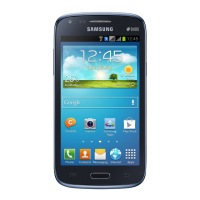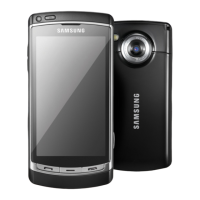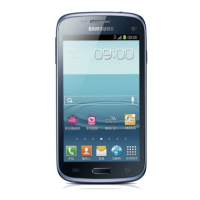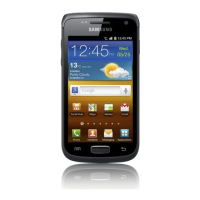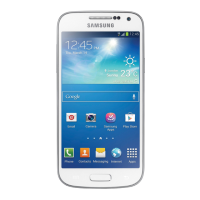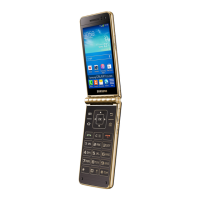Do you have a question about the Samsung GT-I8552 and is the answer not in the manual?
Diagram showing physical components and function of each button.
Installing SIM/USIM cards, battery, and memory cards.
Charging battery, powering on/off, and locking/unlocking the device.
Switching between networks and managing connectivity.
Explaining status icons and guidelines for touch screen interaction.
Managing notifications, home screen, and applications.
Using keyboards and voice input for text entry.
Making, receiving, and managing phone calls.
Adding, editing, searching, and organizing contacts.
Sending and receiving text, multimedia, and email messages.
Using chat apps like Google Talk and social networks.
Accessing the internet, viewing webpages, and using bookmarks.
Enabling and using Bluetooth for wireless connections.
Playing and sharing media content across devices.
Listening to music, managing playlists, and setting ringtones.
Capturing photos and videos using various modes and settings.
Viewing, editing, and managing images and videos.
Accessing online videos and listening to FM radio.
Purchasing and downloading applications and games.
Discovering and downloading Samsung-specific applications.
Recording and managing notes and important information.
Managing events, tasks, and schedules.
Using the clock for alarms, stopwatch, timer, and world clock.
Performing calculations and recording voice memos.
Searching the device and managing files.
Using maps for location services, searching places, and getting directions.
Finding nearby places and navigating to destinations.
Connecting to Wi-Fi networks and managing Bluetooth features.
Tracking data usage and configuring mobile network options.
Adjusting sound, display, language, and home screen settings.
Securing the device with passwords, encryption, and managing backups.
Configuring accessibility features and advanced developer settings.
Resolving common problems like freezes, dropped calls, and touch screen issues.
Resolving issues with Bluetooth and computer connections.
Diagram showing physical components and function of each button.
Installing SIM/USIM cards, battery, and memory cards.
Charging battery, powering on/off, and locking/unlocking the device.
Switching between networks and managing connectivity.
Explaining status icons and guidelines for touch screen interaction.
Managing notifications, home screen, and applications.
Using keyboards and voice input for text entry.
Making, receiving, and managing phone calls.
Adding, editing, searching, and organizing contacts.
Sending and receiving text, multimedia, and email messages.
Using chat apps like Google Talk and social networks.
Accessing the internet, viewing webpages, and using bookmarks.
Enabling and using Bluetooth for wireless connections.
Playing and sharing media content across devices.
Listening to music, managing playlists, and setting ringtones.
Capturing photos and videos using various modes and settings.
Viewing, editing, and managing images and videos.
Accessing online videos and listening to FM radio.
Purchasing and downloading applications and games.
Discovering and downloading Samsung-specific applications.
Recording and managing notes and important information.
Managing events, tasks, and schedules.
Using the clock for alarms, stopwatch, timer, and world clock.
Performing calculations and recording voice memos.
Searching the device and managing files.
Using maps for location services, searching places, and getting directions.
Finding nearby places and navigating to destinations.
Connecting to Wi-Fi networks and managing Bluetooth features.
Tracking data usage and configuring mobile network options.
Adjusting sound, display, language, and home screen settings.
Securing the device with passwords, encryption, and managing backups.
Configuring accessibility features and advanced developer settings.
Resolving common problems like freezes, dropped calls, and touch screen issues.
Resolving issues with Bluetooth and computer connections.
| Model | GT-I8552 |
|---|---|
| Announced | 2013, April |
| Status | Discontinued |
| Network | GSM / HSPA |
| 2G bands | GSM 850 / 900 / 1800 / 1900 - SIM 1 & SIM 2 |
| 3G bands | HSDPA 900 / 2100 |
| GPRS | Yes |
| EDGE | Yes |
| Dimensions | 133.3 x 70.7 x 9.7 mm (5.25 x 2.78 x 0.38 in) |
| Weight | 143.9 g (5.08 oz) |
| SIM | Dual SIM (Mini-SIM, dual stand-by) |
| Display type | TFT capacitive touchscreen, 16M colors |
| Resolution | 480 x 800 pixels (~199 ppi pixel density) |
| Multitouch | Yes |
| Chipset | Qualcomm MSM8625Q Snapdragon 200 |
| CPU | Quad-core 1.2 GHz Cortex-A5 |
| GPU | Adreno 203 |
| Card slot | microSD, up to 64 GB (dedicated slot) |
| Primary camera | 5 MP, AF |
| Video | 720p@30fps |
| Secondary camera | VGA |
| WLAN | Wi-Fi 802.11 b/g/n, Wi-Fi Direct, hotspot |
| GPS | Yes, with A-GPS, GLONASS |
| Radio | FM radio |
| USB | microUSB 2.0 |
| Sensors | Accelerometer, proximity, compass |
| Battery | Removable Li-Ion 2000 mAh battery |
| Also known as | Samsung Galaxy Win |
| Speed | HSPA |
| Display size | 4.7 inches (~64.9% screen-to-body ratio) |
| Pixel density | ~199 ppi |
| OS | Android 4.1 (Jelly Bean) |
| Internal memory | 8 GB |
| Features | LED flash |
| Bluetooth | A2DP |
| Colors | White |


